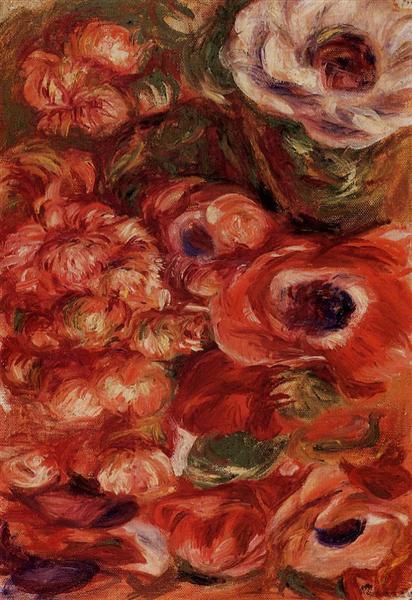תיאור
Pierre-Auguste Renoir's Anemones is a sublime representation of the vibrant and romantic qualities inherent in the artist's style, a central figure in the 19th-century Impressionist movement. In this painting, Renoir captures the essence of anemone flowers with a delicacy that evokes both their natural beauty and their fragility. The work is characterized by a rich and luminous palette, where shades of white, red and green intertwine to create a composition that is bursting with life.
The arrangement of color in “Anemones” is central to its visual impact. Renoir employs an almost tactile approach, where short, loose brushstrokes provide a sense of vibrant movement. The variation in tones in the anemones, from pearly white to deep red, reflects not only the light falling on them, but also a deep understanding of the ephemeral nature of beauty. The exuberance of the flowers is framed by a soft, diffuse background that does not compete with the main spectacle, but rather serves to further accentuate them, inviting the viewer to focus on the central subject.
It is interesting to note that this composition does not feature any human figures, a distinctive feature of many of Renoir's works, who often integrated his contemporaries into scenes of everyday life. However, Anemones delves into a phenomenon that Renoir explored on several occasions: the purity of natural moments. This choice to emphasize nature over the human figure can be seen as a reflection of his deep resonance with landscape and flora, aspects that were often overshadowed by his fascination with social life and depictions of female beauty in other works.
The technique used in this work stands as a testament to the evolution of Impressionism towards a greater exploration of light and colour. Renoir, in his quest to capture the essence of the moment, uses the effect of light to bring his subjects to life. The subtly nuanced shadows on the anemones suggest a three-dimensionality that makes the flowers seem to come alive on the canvas, while the splashes of complementary colour and smooth transitions suggest the warmth and intimacy of a serene garden.
When analyzing “Anemones” in the context of Renoir’s oeuvre, it is essential to mention his other floral compositions, which reflect his love of nature and a more contemplative and sensorial approach. These works can often be seen as counterparts to his scenes of social life, restrained but equally potent in their emotion. “Anemones” not only reinforces his legacy as a master of color and light, but also showcases his ability to transcend conventional representations, offering the viewer a space for reflection and appreciation of the ephemeral.
In short, Anemones is a work that encapsulates the essence of Impressionism through the exploration of light, color and the beauty of nature. The painting stands as a testament to the genius of Renoir, a master who, through his soft brushstrokes and vibrant palette, managed to immortalize the delicacy of flowers, speaking powerfully about the transience of life itself.
KUADROS ©, a famous painting on your wall.
Hand-made oil painting reproductions, with the quality of professional artists and the distinctive seal of KUADROS ©.
Painting reproduction service with satisfaction guarantee. If you are not completely satisfied with the replica of your painting, we will refund 100% of your money.

